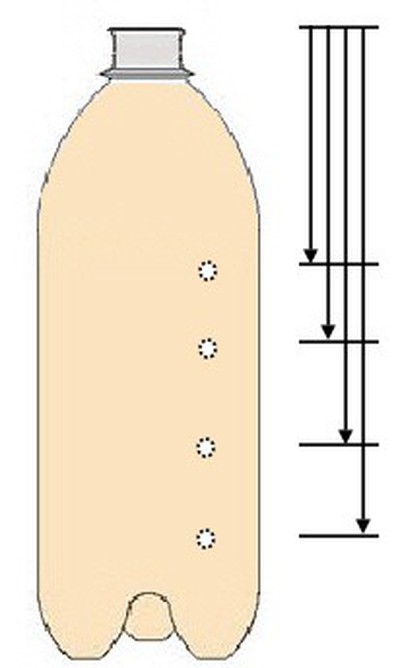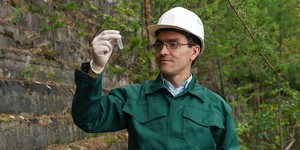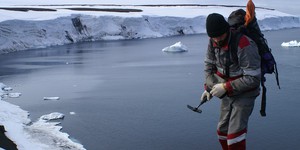Abstract
This project shows you how to build a simple model system to simulate underground water flow. Underground water flow is important for understanding replenishment of underground aquifers, migration of underground contaminant plumes, and cave formation. With your model system, you can simulate various underground conditions, and test your predictions about the effects they have on water flow.Summary
Andrew Olson, Ph.D., Science Buddies
Sources
This project is based on:
- Gevorkian, G., 2004. Darcy's Law and Underground Water Flow, California State Science Fair Abstract. Retrieved November 30, 2006.

Objective
The goal of this project is to model the flow of groundwater, and to calculate the flow rate using Darcy's formula.
Introduction
Fresh water exists not only in lakes and streams on the surface of the earth, but also underground. These subsurface sources of freshwater are called underground aquifers, and the water in them is called groundwater.
Like water on the surface, groundwater can also flow. And like water on the surface, groundwater also flows downhill. Groundwater can also move in response to differences in pressure from the overlying rock, soil, and water. The rate of groundwater flow will also depend on the material through which the water is flowing. Materials that are more solid will reduce the flow rate, while materials that are more porous will increase the flow rate.
Darcy's Law is a relationship that explains fluid flow in porous media, such as often seen in geological formations. The basic formula to calculate the flow rate, Q, is:
where:
- K is a permeability coefficient (describes the porosity of the underground formation)
- A is the cross sectional area
- h1 is the height of the inlet head
- h2 is the height of the outlet head
- L is the path length of the flow
Understanding how groundwater moves is important for predicting how quickly underground aquifers will be replenished when water is drawn up from wells drilled down from the surface. Sometimes groundwater can become tainted with salt water or even toxic compounds seeping from a contaminated source. In these cases it is especially important to understand groundwater movement, in order to contain the spread and prevent contamination of aquifers used for drinking water or irrigation.
In this project, you will use plastic soda bottles to make models of water flowing through underground formations. You will fill the bottles with different materials (e.g., sand, gravel, silty clay, etc.) and then measure water flow to see the effects of different types of formations. You can investigate the effects of pressure by making outlets at different heights on the bottle. The height of the water above the outlet creates the pressure, so the lower the outlet is, the more pressure there will be. By measuring the flow rate at the outlet, you can see how well Darcy's Law predicts your results.
Terms and Concepts
- Groundwater
- Aquifer
- Porosity
- Darcy's Law
- Artesian well
- Drawdown
Bibliography
These websites will help you get started with your background research on groundwater and Darcy's Law:
- Ground Water Protection Council. (n.d.). Fluid Flow in the Subsurface (Darcy's Law). Ground Water Protection Council (GWPC). Retrieved September 20, 2023.
- USGS Water Science School. (2018, October 9). Groundwater Information by Topic. U.S. Geological Survey. Retrieved September 21, 2023.
- Encyclopedia Britannica, Inc. (n.d.). Darcy's law. Retrieved March 5, 2013.
Materials and Equipment
To do this experiment you will need the following materials and equipment:
- 2 L plastic bottles (4 or more)
- Plastic tubing (e.g., aquarium tubing, drinking straw). Plastic tubing may be available locally from aquarium or hardware shops or online from suppliers such as Carolina Biological, catalog #671784.
- Sharp knife
- Modeling clay
- Graduated beaker for measuring outflow. A 400 ml glass beaker is available from Carolina Biological, catalog #721210. Alternatively, a large, graduated measuring cup may be used.
- Timer or stopwatch
- Material to simulate subsurface, e.g.:
- Pea gravel
- Aquarium gravel
- Sand
- Clay soil
- Mixtures of clay and sand
Disclaimer: Science Buddies participates in affiliate programs with Home Science Tools, Amazon.com, Carolina Biological, and Jameco Electronics. Proceeds from the affiliate programs help support Science Buddies, a 501(c)(3) public charity, and keep our resources free for everyone. Our top priority is student learning. If you have any comments (positive or negative) related to purchases you've made for science projects from recommendations on our site, please let us know. Write to us at scibuddy@sciencebuddies.org.
Experimental Procedure
- Do your background research and make sure that you are knowledgeable about the terms, concepts, and questions, above.
-
Prepare at least four 2 L bottles for measuring flow rates, as described in Figure 1:
 Image Credit: John LeVasseur / Copyrighted
Image Credit: John LeVasseur / Copyrighted
Figure 1. Each soda bottle should have a single outlet hole. Make four bottles, each with an outlet hole at a different height. To collect the outflow, connect a short length of drinking straw or aquarium tubing to the outlet hole, and seal the edges with modeling clay. Use a large measuring cup or other graduated container to catch the outflow. (Thanks to John LeVasseur for the soda bottle drawing from which this diagram was adapted.) -
To investigate the effect of pressure on underground water flow, compare the flow rate from the different outlet holes. Fill each bottle with the same medium (e.g., sand).
- Keep the water level in the bottle constant by pouring water in at the top.
- Measure the outflow by collecting the water in a graduated container and measuring how much water you collect in a given time period (e.g., 10, 20, or 30 seconds).
- Convert your flow rate to liters per minute for comparing the different conditions.
- Calculate the pressure head for each condition by measuring the difference between the heights of the inlet (h1) and outlet (h2). The arrows in Figure 2 show the pressure head (h1 − h2) for each of the outlet holes.
- Graph your results by plotting flow rate (y-axis) vs. delta h (the inlet height minus the outlet height, as shown in Figure 1). How well does Darcy's Law predict your results?
- To investigate the effect of different materials on underground water flow, use different materials to fill the bottles. Compare the measured flow rates for the different materials (using outlets at the same height). Can you use Darcy's Law to calculate the K value (permeability coefficient) for each material?
Ask an Expert
Global Connections
The United Nations Sustainable Development Goals (UNSDGs) are a blueprint to achieve a better and more sustainable future for all.
Variations
- What do you think will happen to flow rate if you change the diameter of the bottle? Can you relate this change to groundwater movement?
- What do you think will happen to the flow rate if you change the diameter of the outlet tubing?
Careers
If you like this project, you might enjoy exploring these related careers:









